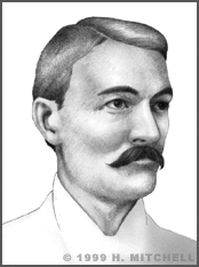George Ferris
George Ferris conceived, designed, and built an engineering marvel, which astonished the world at its debut and became a mainstay of American recreation.
George Washington Gale Ferris was born in Nevada in 1859. He attended high school in Oakland, California before enrolling at Rensselaer Polytechnical Institute in Troy, New York, where he graduated in 1881 with a degree in engineering. Ferris found civil engineering work in Pittsburgh, where he specialized in constructing steel frameworks for bridges and tunnels.
When the World's Columbian Exhibition of 1893 was being planned in Chicago, the 33-year-old Ferris arrived hoping to help build a structure that could outdo the Eiffel Tower, the centerpiece of the Paris Exhibition of 1889. The Exhibition's planners wanted something "original, daring, and unique." Inspired, Ferris sketched a huge, revolving "observation wheel" on some scrap paper that same night in detail, down to the ticket price. The next day, he presented his idea to the committee. They had heard of the smaller, wooden "pleasure wheels" that had begun to appear at various vacation spots about twenty-five years before, but, seeing the sheer size of Ferris' wheel, the committee dismissed him as a crackpot. A few weeks later, Ferris returned to the committee. He had convinced several fellow engineers to endorse his structure as both buildable and safe. More importantly, he had found local investors to cover the $400,000 cost to construct them. This time, Ferris' plan was approved.
Ferris' wheel was modeled on a bicycle wheel. It had heavy steel beams that acted as spokes to maintain the wheel's shape and balance. The "forks" in which the axle was set were two steel girder pyramids. The wheel was 264 feet high, the supporting towers were 140 feet high, and the axle – the largest piece of steel ever forged in the U.S. – weighed 46 1/2 tons. The wheel carried 36 elegantly outfitted passenger cars, each of which could fit 40 people sitting or 60 people standing. The wheel was spun by either of two 1,000 horsepower steam engines and stopped by an oversized air brake.
Ferris' innovative design, a model of efficiency, let the wheel withstand Chicago's infamous winds while being able to hold about five times the 1,200 tons that it carried when fully loaded. At its opening on June 21, 1893, the Ferris Wheel became the irresistible centerpiece of the Exhibition. As one reviewer put it, "You cannot advertise the wheel, anyway, any more than you can advertise the fair or the Atlantic Ocean. They are all too big."
Operating without a hitch throughout the Exhibition, Ferris' wheel carried an estimated 1 1/2 million visitors, each paying 50 cents (equal to the Exhibition's general admission charge) for a 20-minute ride. After the Exhibition ended, the owners of resorts like Coney Island stole Ferris' idea. Worse yet, Ferris thought the Exhibition management had robbed him and his investors of their rightful portion of the nearly $750,000 profit that his wheel brought in.
Unfortunately, George Ferris, the author of this uniquely beautiful and modern amalgam of spirit, form, and function, spent the next two years in litigation, then died prematurely in late 1896. However, his name lives on in the "observation wheels" that can now be found in virtually every amusement park in the world.


